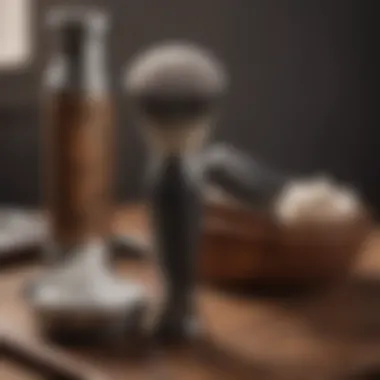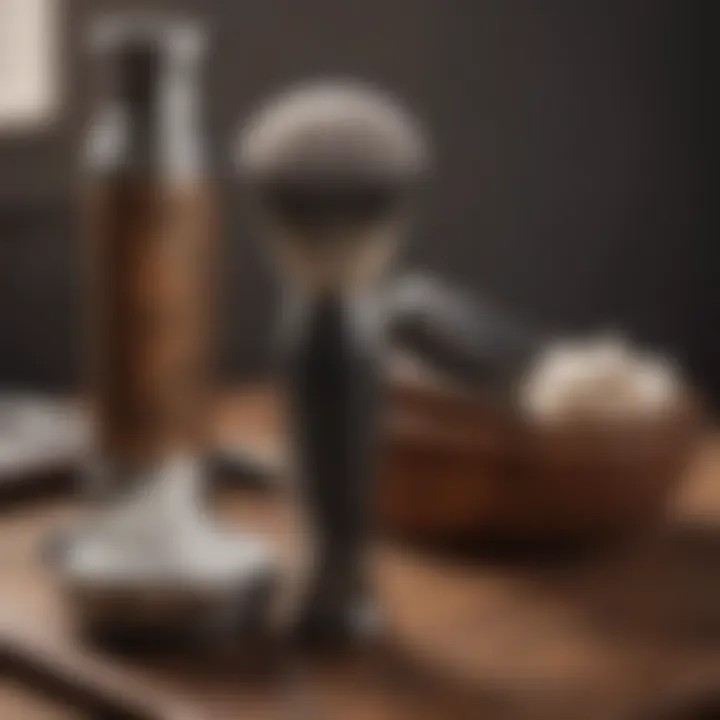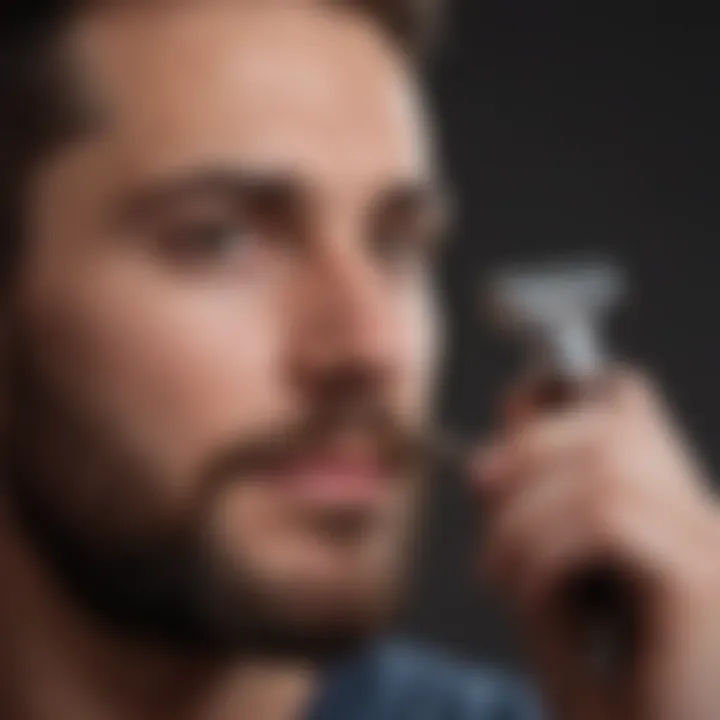Mastering the Art of Beard Shaving: A Complete Guide


Intro
Grooming is a vital part of personal style, and for many men, the act of shaving their beard is a ceremonious ritual that combines both function and artistry. Understanding the correct process of shaving is compelling not only for aesthetic appeal but also for the sake of skin health and comfort. In this guide, we will cover essential tools, proper techniques, and aftercare practices. Additionally, we’ll discuss common pitfalls during shaving and how to avoid them, equipping readers with the skills they need for a successful shaving experience.
Essential Tools for a Successful Shave
Before one begins the process, having the right tools is paramount. Quality products can greatly enhance the experience and results. Here are some must-have items:
- Razor: A sharp, clean razor is crucial. The type—whether straight, safety, or cartridge—depends on personal preference. Each has its own characteristics and requiring different techniques.
- Shaving Cream or Gel: A good lathering product protects your skin and allows the razor to glide smoothly. Look for hydration and soothing properties.
- Pre-Shave Oil: This can provide extra lubrication, making the shave smoother and reducing irritation.
- After-Shave Balm: This helps to soothe the skin post-shave and can prevent razor burn.
Having these tools in your kit lays the foundation for a clean, comfortable shave.
Technique: The Steps to Shave Your Beard
The act of shaving involves several steps that need careful consideration:
- Preparation: Start with a clean face. Wash with warm water to open pores. It allows for an easier shave and enhances skin condition.
- Applying Pre-Shave Oil: Use a few drops of pre-shave oil to your damp skin. It acts as a lubricant and safeguards against irritation.
- Lather Up: Apply your chosen shaving cream or gel with a brush or your hands, creating a thick layer.
- Shaving Direction: Begin shaving in the direction of hair growth. This reduces irritation and minimizes the chance of ingrown hairs. If a closer shave is desired, a second pass can be made across the grain.
- Rinse: After each stroke, rinse the blade to keep it clean. This ensures a smoother process and prevents clogged blades.
- Post-Shave Care: Rinse off excess cream and pat your face dry. Follow up with after-shave balm to hydrate and soothe.
Common Mistakes to Avoid
Even the most seasoned groomers can fall into traps. Here are common mistakes that can lead to irritation or an unsatisfactory shave:
- Shaving with a dull blade: Duller razors pull at hair rather than cutting it, causing discomfort.
- Skipping preparation: Neglecting to wash the face or apply pre-shave oil can result in irritation.
- Pressing too hard: The weight of the razor should do most of the work. Pressing can lead to nicks and cuts.
"A well-prepared face is half the journey to a flawless shave."
Finale
Shaving your beard correctly is a skill that takes practice and understanding. By mastering the right techniques and using appropriate tools, men can achieve not only a smooth face but also maintain skin health. This guide serves as a detailed resource aimed at aiding you in refining your shaving technique, ultimately enhancing your grooming routine and overall personal style.
Prolusion to Beard Shaving
The act of shaving one’s beard extends beyond mere grooming; it is a ritual that reflects personal style and self-care. Understanding the correct technique is crucial for achieving an optimal result and avoiding irritations. This article seeks to equip men with the necessary tools, techniques, and knowledge to enhance their shaving experience.
Aiming for a clean shave can significantly impact one’s appearance. Proper beard shaving emphasizes facial features, enhances confidence, and allows for versatility in style choices. The importance of having an established routine cannot be overstated. Each phase of the shaving process requires specific attention to detail, from selection of tools to aftercare practices.
Moreover, many men overlook skin preparation. This can result in uneven shaves and skin irritation. Understanding your own skin type, beard texture, and growth patterns contributes to a more personalized and effective shaving routine. Thus, recognizing these elements plays a vital role in the overall outcome.
Shaving is also a form of art that requires practice and patience. Mastering it can lead to a polished appearance that demands respect.
"A well-groomed beard shows you care about your appearance."
In summary, an informed approach to beard shaving not only enhances personal aesthetics but also cultivates a respect for grooming as an essential aspect of daily life. A successful shave is one that combines the right tools, methods, and aftercare, culminating in a refined look. This article will go in-depth into every aspect associated with this grooming practice.
Understanding Your Beard Type
Understanding your beard type is crucial in achieving an effective shave. This knowledge can significantly impact the overall result, influencing your choice of tools and techniques. Each individual has a unique beard texture and growth pattern, which necessitates different approaches for proper shaving. Identifying these characteristics allows for better handling of potential challenges, ultimately leading to a smoother and cleaner shave. Moreover, it enhances comfort during the process.
Different Beard Textures
Beard textures can vary greatly. They generally fall into three categories: straight, wavy, and curly. Recognizing your beard texture can help you choose the right tools and techniques. Straight hairs are usually easier to manage when shaving and require less effort to achieve a smooth finish.
Wavy textures tend to be moderate and can sometimes create challenges, such as resistance against razors. Curlier beards, on the other hand, can be more complex. They often require tools designed for thicker hair. For instance, a razor that works effectively on straight beards might struggle with curls. Therefore, selecting the appropriate razor and technique for your specific beard structure is important to avoid discomfort and ensure precision.
- Straight: Easier to shave, presents a smooth surface.
- Wavy: Moderate difficulty, may require different angles during shaving.
- Curly: Often needs specialized tools, managing curls can be more involved.
Growth Patterns
Growth patterns refer to the direction in which the beard hairs grow. Recognizing these patterns will inform your shaving strategy. Beard hairs can grow downwards, upwards, or in various directions throughout the face. Understanding how your facial hair grows can help avoid unnecessary irritation and cuts.
It's common to see hair grow in distinct patterns on different parts of the face. For instance, the cheeks may have a downward growth while the neck might grow upwards. The approach to shaving should always consider these directions. Shaving against the grain can sometimes lead to closer cuts, but it may also increase the risk of irritation. It’s essential to find a balance that works best for your growth patterns.
"Taking the time to understand your beard type is the first step toward a successful shaving experience."
In summary, knowing your beard texture and growth pattern is essential. It allows for tailored shaving practices that cater to your unique hair characteristics. This understanding results in better preparation, smoother shaves, and improved overall satisfaction.


Essential Tools for Proper Shaving
To achieve the best shaving outcomes, understanding essential tools is crucial. The right tools not only enhance the efficiency of the shaving process but also contribute significantly to the health and comfort of your skin. Proper tools can minimize irritation and ensure a smoother shave. Each element plays a distinct role, and knowing how to select and use them is key to excellent grooming.
Razors: Choosing the Right Type
Selecting the appropriate razor is the foundational step in any effective shaving routine. You have options: straight razors, safety razors, and cartridge razors. Each type has its advantages and limitations.
- Straight Razors: These provide the closest shave but require skill and regular maintenance. They are often favored by traditionalists.
- Safety Razors: Ideal for beginners, safety razors are easier to handle while still offering a close shave. They reduce the risk of nicks and cuts compared to straight razors.
- Cartridge Razors: These are convenient and widely available. Their multi-blade design allows for a quick shave but may lead to skin irritation for some.
Consider factors like your skin sensitivity and beard density when making your choice. A good razor can significantly improve your shaving experience, so investing in quality is recommended.
Shaving Creams and Soaps
A proper shaving cream or soap is vital for preparing your skin. These products help to soften the hair and form a protective layer that reduces friction. When choosing a shaving cream or soap, consider the following:
- Ingredients: Look for moisturizers like glycerin or aloe vera. Avoid harsh chemicals which can irritate the skin.
- Type of Product: Creams are easier to lather and apply, while soaps may provide a richer feel when applied correctly.
- Fragrance: Choose a scent that complements your preferences but avoid overly strong fragrances that can cause irritation.
It’s essential to use ample product to create a thick lather, as this helps the razor glide smoothly over the skin, ensuring a comfortable shave.
Post-Shave Products
Post-shave care is crucial for maintaining skin health and comfort after shaving. Using the right products can reduce irritation, replenish moisture, and soothe the skin. Key post-shave products include:
- Aftershave Lotion or Balm: This is used to nourish and protect the skin after shaving. Look for products free from alcohol, as they can be drying.
- Moisturizer: A gentle moisturizer helps to lock in hydration and keep the skin supple. Ideally, it should contain soothing ingredients.
- Healing Ointments: If you have sensitive skin or experience irritation, using a soothing ointment can help in recovery.
Taking proper care following the shave not only enhances comfort but also supports long-term skin health, ensuring your grooming routine leaves you feeling fresh and confident.
Preparation Steps Before Shaving
Preparation is a crucial phase in the shaving process. A well-prepared face leads to a smoother shave and reduces the risk of irritation. Neglecting this step can result in painful, uneven results and ultimately damage the skin. Understanding how to prepare properly can transform your shaving routine from a chore into an efficient and enjoyable experience.
Cleaning Your Face
Before taking any shaving action, it's essential to start with a clean slate. Washing your face removes dirt, oil, and any dead skin cells. Ideally, use a gentle facial cleanser tailored for your skin type. A product that balances moisture and removes impurities will work best.
To wash your face, wet it with warm water to open the pores. Apply the cleanser using circular motions for about 30 seconds, then rinse thoroughly. This ensures that your beard is fresh and ready for shaving. If you skimp on this step, the risk of clogged razors increases, leading to cuts and discomfort. By cleansing effectively, you create conditions for a more precise shave, making it easier for the blade to glide smoothly across your skin.
Hydration Techniques
Hydration prepares both your beard hair and skin, softening them for the shave. This can significantly minimize friction, which may cause irritation during shaving. One effective technique is to splash warm water on your face before shaving. Alternatively, shaving after a hot shower can be particularly beneficial. The steam from the hot water not only raises the hair follicles but also provides hydration.
Applying a warm towel to your face for a few minutes can achieve similar results. The heat and moisture help in softening the hair, allowing for a closer shave. If you do not hydrate beforehand, dry hair can lead to tugging, which is uncomfortable and can irritate the skin.
Using Pre-Shave Oil
Pre-shave oil acts as a barrier that enhances both razor glide and overall comfort. This oil conditions the hair, enabling a smoother cut while providing additional moisture to the skin. Applying a small amount of pre-shave oil before the cream or soap significantly reduces the likelihood of nicks and cuts.
To use pre-shave oil, massage a few drops into your damp skin for about a minute. This allows the oil to penetrate and prepare the hair for shaving. Seek oils that are lightweight and absorb easily, as thicker oils can clog the razor. Using this product is an essential addition for those prone to sensitive skin or who shave regularly.
"Preparation makes all the difference in achieving a clean, effective shave."
By investing time into these preparation steps, you are not just working toward a close shave. You are also prioritizing the health of your skin and enhancing your overall shaving experience. Skipping these steps will likely lead to a less satisfying outcome. In contrast, a well-prepared face will set the stage for a higher quality shave.
The Shaving Process: Step-by-Step
The shaving process is integral for achieving a precise and clean shave. It goes beyond just using a razor. Each step in this process requires careful consideration to ensure the best results. Following a structured approach can help minimize irritation and enhance the overall shaving experience.
Lathering Techniques
Lathering is a crucial step that sets the foundation for a successful shave. The purpose of lathering is to create a protective barrier on the skin, allowing the razor to glide smoothly. To create an effective lather, it is advisable to use either shaving cream or soap.
- Wet Your Brush: If you are using a shaving brush, wet it in warm water before application.
- Apply Product: Take a small amount of shaving cream or soap and place it in a bowl or directly on your face.
- Whip It Up: Using circular motions, work the brush into the cream or soap until a rich, creamy lather develops. This can also be done with your hands for a more straightforward approach.
- Cover Your Face: Spread the lather across your beard area, ensuring even coverage. This helps to soften the hair and prepares the skin for shaving.
Lathering not only softens the beard but also helps in retaining moisture, making it an essential part of the shaving process.
Shaving with the Grain


Shaving with the grain means moving the razor in the direction of hair growth. This practice reduces tugging and minimizes the risk of irritation or razor bumps.
- Identify Hair Growth Direction: Take a moment to observe how your hair grows. This varies for each person, as some might have multiple growth patterns.
- Use Light Pressure: When you begin to shave, apply light pressure to the razor. Allow the blade to do the work.
- Short Strokes: Use short, controlled strokes. This helps in maintaining better control and reduces the chances of missing spots.
- Rinse the Razor: Regularly rinse the blade to clear it of hair and lather, ensuring the shave remains effective.
This technique is critical for reducing the likelihood of post-shave redness and discomfort.
Addressing Problem Areas
Each individual's face has unique problem areas that require special attention. These might include the neck, jawline, or areas where hair grows in different directions.
- Focus on Sensitive Areas: Be particularly gentle when shaving sensitive spots. This is where irritation is more likely to occur.
- Adjust Your Technique: For areas where hair grows against the grain, it might be necessary to adjust your angle or consider a second pass once the initial shave is complete.
- Effective Use of Razor: Always ensure the razor is sharp. Dull blades are more prone to pulling hair instead of cutting, leading to razor burn.
- Post-Shave Inspection: After shaving, take a close look to ensure all hairs are addressed. If missed spots remain, use a light hand to clean those areas carefully.
Addressing problem areas effectively ensures a cleaner and more polished look.
By perfecting your shaving technique, you not only enhance your appearance but also develop a grooming routine that reflects a well-maintained personal style.
Post-Shaving Care
Post-shaving care is crucial yet often overlooked. Proper care after shaving helps maintain skin health and contributes to a more pleasant shaving experience in future sessions. Neglecting this step can lead to skin irritation, dryness, and discomfort, which are certainly not desired outcomes. Thus, it is imperative to adopt an effective post-shaving routine that promotes skin recovery and comfort.
Cleaning the Skin After Shaving
Once shaving is completed, the very first thing to do is clean the skin. Rinsing the face with cool water helps remove shaving cream residue and any loose hair. Cool water is preferred as it helps in closing the pores, which can minimize irritation. Using a gentle cleanser can also be beneficial. Look for a product that is free from harsh chemicals or strong fragrances. This ensures that the skin remains free from irritants while providing a refreshing feeling after shaving. Avoid vigorous scrubbing, as the skin can be sensitive after the blade has made contact with it.
Moisturizing Techniques
Moisturizing is a vital part of post-shaving care. It prevents the skin from drying out and aids in repair. After washing the face, apply a suitable moisturizer. Products containing essential ingredients like aloe vera or glycerin are often effective. These ingredients not only hydrate but also soothe the skin. For those with oily skin, a lightweight, oil-free moisturizer is recommended, while those with dry skin might benefit more from a rich cream.
- Look for products labeled as non-comedogenic. This ensures that they won’t clog the pores.
- Applying moisturizer shortly after shaving allows for better absorption, maximizing its effectiveness.
Dealing with Irritation
Irritation can be a common issue following shaving. When irritation occurs, it is essential to address it promptly. Several measures can help alleviate discomfort. First, a cooling aftershave balm can be advantageous. Products with calming agents such as chamomile or witch hazel can provide immediate relief.
Additionally, if irritation persists, consider using a cortisone cream occasionally. However, make sure to consult with a healthcare professional before using any medicated product.
Regularly applying soothing products after shaving can significantly reduce skin redness and enhance overall skin texture.
Culmination
Common Mistakes and How to Avoid Them
Understanding common mistakes in beard shaving is crucial for achieving a clean and polished look. Avoiding these errors enhances not only the efficiency of your shave but also the health of your skin. Many men may underestimate the importance of preparation and the time dedicated to shaving. This section will help identify prevalent errors, offering you solutions to refine your shaving routine effectively.
Rushing the Shaving Process
One of the most significant errors men make while shaving is rushing through the process. In our fast-paced world, it is easy to treat shaving as a mere chore. However, haste often leads to a variety of issues. Skin irritation and uneven cuts can occur, making the results less than desirable.
To avoid this mistake, allocate an appropriate amount of time for the complete shaving routine. It is recommended to set aside at least 10 to 15 minutes to ensure every step is executed with care. This time allows for not only the act of shaving but also for the preparation and post-shave care required for maintaining skin health.
In addition, consider the mental aspect of shaving. Take a moment to relax and focus. This practice will not only enhance your technique but may also transform shaving into a more enjoyable part of your grooming routine.
Neglecting Skin Preparation
Another critical mistake is neglecting skin preparation. Many men skip this essential step, believing that simply applying shaving cream will suffice. However, proper preparation is vital for a comfortable shave and healthy skin.
Preparation involves cleansing the face to remove dirt and oil. This can be achieved using a mild facial cleanser, which helps to unclog pores. After cleansing, it is important to hydrate the skin, preferably with warm water or a warm towel, to soften hair follicles. This preparation significantly reduces the chances of irritation and nicks.
Additionally, using a pre-shave oil is recommended. This product creates a barrier between the blade and the skin, providing extra lubrication and protection. Doing so not only enhances the gliding motion of the razor but also contributes to a smoother overall shaving experience.
In summary, by taking the time to prepare your skin adequately and avoiding the temptation to rush, you can achieve an efficient and satisfying shave. Recognizing these common mistakes and implementing corrective measures will lead to better grooming habits and a more polished appearance.
"Preparation is the key to success in shaving, just like in many areas of life."
Consider these aspects carefully, as they hold considerable weight in establishing a successful shaving routine.
Innovations in Shaving Technology


Innovations in shaving technology have transformed the grooming experience significantly in recent years. This evolution ensures that the process not only becomes more efficient but also adapts to the various needs of users. As men increasingly pay attention to their personal grooming, understanding these advancements can enhance their shaving routine to achieve desirable results. This section delves into the two main innovations: electric shavers and smart shaving devices.
Electric Shavers vs. Traditional Razors
When choosing between electric shavers and traditional razors, several factors come into play. Electric shavers offer convenience and speed. They can be used dry or with shaving cream, depending on the model. Users often find that electric shavers reduce the risk of nicks and cuts, making them suitable for sensitive skin.
On the other hand, traditional razors are often favored for their closeness of shave. Men who prefer a meticulous grooming process may find that using a double-edge safety razor provides a fine, smooth finish that electric shavers may not match. Traditional razors can be more time-consuming but can enhance the ritual and satisfaction of shaving.
The decision may hinge on several considerations:
- Convenience: Electric shavers are quicker for routine use.
- Skin Sensitivity: Electric models minimize irritation for some, while others prefer the classic blade experience.
- Cost: Electric shavers require an upfront investment, whereas traditional razors often entail recurring costs for blades.
Choosing between electric shavers and traditional razors depends on individual preferences, lifestyle, and grooming standards.
Smart Shaving Devices
Smart shaving devices are a more recent introduction into the shaving world. These products integrate technology to enhance the user experience. Features often include sensors for real-time feedback on skin type, allowing for customized shaving routines. These devices also frequently offer apps that provide shaving tips and track shaving habits.
Benefits of smart shaving devices can include:
- Precision: Algorithms can adjust the shaving speed and pressure according to the user's skin type.
- Feedback: Continuous monitoring helps in achieving a closer and safer shave.
- User Guidance: Interactive tutorials can help users improve their technique and avoid common mistakes.
"With the growth of smart home technology, shaving devices are also becoming smarter. This evolution not only reflects changing lifestyles but also contributes to better grooming results."
Cultural Perspectives on Shaving
Understanding the cultural perspectives on shaving is essential for men who want to develop a more nuanced view of grooming. Shaving is not only a personal hygiene practice but also a significant aspect of cultural identity, social norms, and even fashion trends. Different cultures approach shaving with distinct traditions, reflecting values and beliefs that are unique to their society. Exploring these perspectives can help one appreciate the intricate relationship between grooming practices and cultural significance.
Historically, shaving has marked various societal transitions. For many civilizations, a shaved face symbolized youth and vigor, while in others, facial hair signified maturity and wisdom. The motivations behind shaving��—whether for aesthetics, religion, or tradition—offer insights into the shared values of communities. Across various cultures, specific styles have emerged that resonate with the local identity, adding layers of meaning to the act of shaving.
Historical Trends in Beard Styles
Throughout history, beard styles have changed dramatically. In Ancient Egypt, for example, the pharaohs wore elaborate false beards made of metal or cloth, signifying royalty and divinity. Similarly, in Ancient Greece, beards represented masculinity and wisdom, with many philosophers embracing facial hair as a symbol of intellectual depth.
In the Middle Ages, beards were often viewed as a sign of virility, and during the Renaissance, changing styles parallel cultural shifts in art and philosophy. More recently, the 18th and 19th centuries saw a variety of interpretations, from the stylish mutton chops to the sophisticated chinstrap. Each era brings its own focus, influenced by social movements and political changes.
Considering the diverse historical narratives surrounding beard styles, it becomes clear that grooming has always been a reflection of cultural ideologies and identity.
Contemporary Influences
In today's society, celebrities and influencers play a significant role in shaping current grooming trends. Social media has amplified these influences, allowing styles to circulate at an unprecedented rate. From the well-groomed beards of actors like Jason Momoa and Chris Hemsworth to the clean-cut looks often sported by athletes, these figures set trends that resonate with many men.
Moreover, contemporary grooming trends are now inclusive of various styles that cater to different demographics and cultural backgrounds. Many men are experimenting with bold styles and personalizing their grooming routines. The rise of grooming brands specifically targeting men, such as Beardbrand and Dollar Shave Club, further emphasizes the shift in male grooming culture towards a more elaborate and expressive practice.
As societies become more globalized, the cross-pollination of cultural grooming practices becomes evident. Men today no longer feel constrained by traditional boundaries, allowing for an expansive exploration of styles.
This evolution in grooming signifies not just a change in fashion but also a broader acceptance of individual expression within cultural contexts.
In summary, cultural perspectives on shaving provide rich insights into the personal and social dimensions of grooming. By understanding historical trends and contemporary influences, men can refine their shaving practices while appreciating the deeper connections between culture, identity, and style.
End: The Shaving Experience
The act of shaving is often perceived as a mundane part of daily grooming, but it holds far more significance than merely removing hair. This article has explored the nuances of shaving your beard correctly, emphasizing the associated techniques, tools, and post-shaving care. A proper shaving routine is vital, especially for men who value their personal grooming and style. It not only influences one’s appearance but also affects skin health, self-confidence, and overall well-being.
Benefits of a Well-Crafted Shaving Routine
A well-planned shaving experience can yield several benefits:
- Enhanced Skin Health: Using the right products and techniques reduces irritation and keeps the skin hydrated.
- Improved Appearance: Regular and careful shaving can lead to a cleaner, well-groomed look that reflects personal style.
- Boost in Confidence: Feeling good about your appearance often translates to increased self-esteem and assurance.
Considerations for a Superior Shaving Experience
To fully appreciate the art of shaving, one must consider the importance of refining routines. Adaptation to changing beard growth patterns or skin conditions should always be on the horizon. Not all men will achieve the desired results using identical methods. Personalization of the approach can involve experimenting with various razors, creams, or even techniques until a satisfying routine emerges.
"A great shave is not just about the act itself, but the overall experience it provides."
Ultimately, the conclusion of the shaving experience ties back to the importance of continual improvement in one’s grooming habits. It’s about developing a deep understanding of how to achieve not only a clean shave but an excellent overall experience that enriches both appearance and confidence.
Refining Your Shaving Routine
Creating a personalized shaving routine involves several key aspects. These include:
- Daily Assessment: Notice changes in your beard growth and skin condition, adapting your routine accordingly.
- Product Selection: Invest time in choosing products that cater specifically to your skin type and beard texture.
- Regular Maintenance: Replace razors and refresh your shaving creams or soaps regularly to ensure optimal performance.
A refined shaving routine minimizes the chances of irritation and maximizes the comfort factor. Careful experimentation can lead to finding the perfect balance between efficiency and care.
In summary, the shaving experience should never be rushed or taken for granted. By focusing on refinement and personal standards, men can ensure that this routine becomes not just a task but an integral part of their grooming identity.















